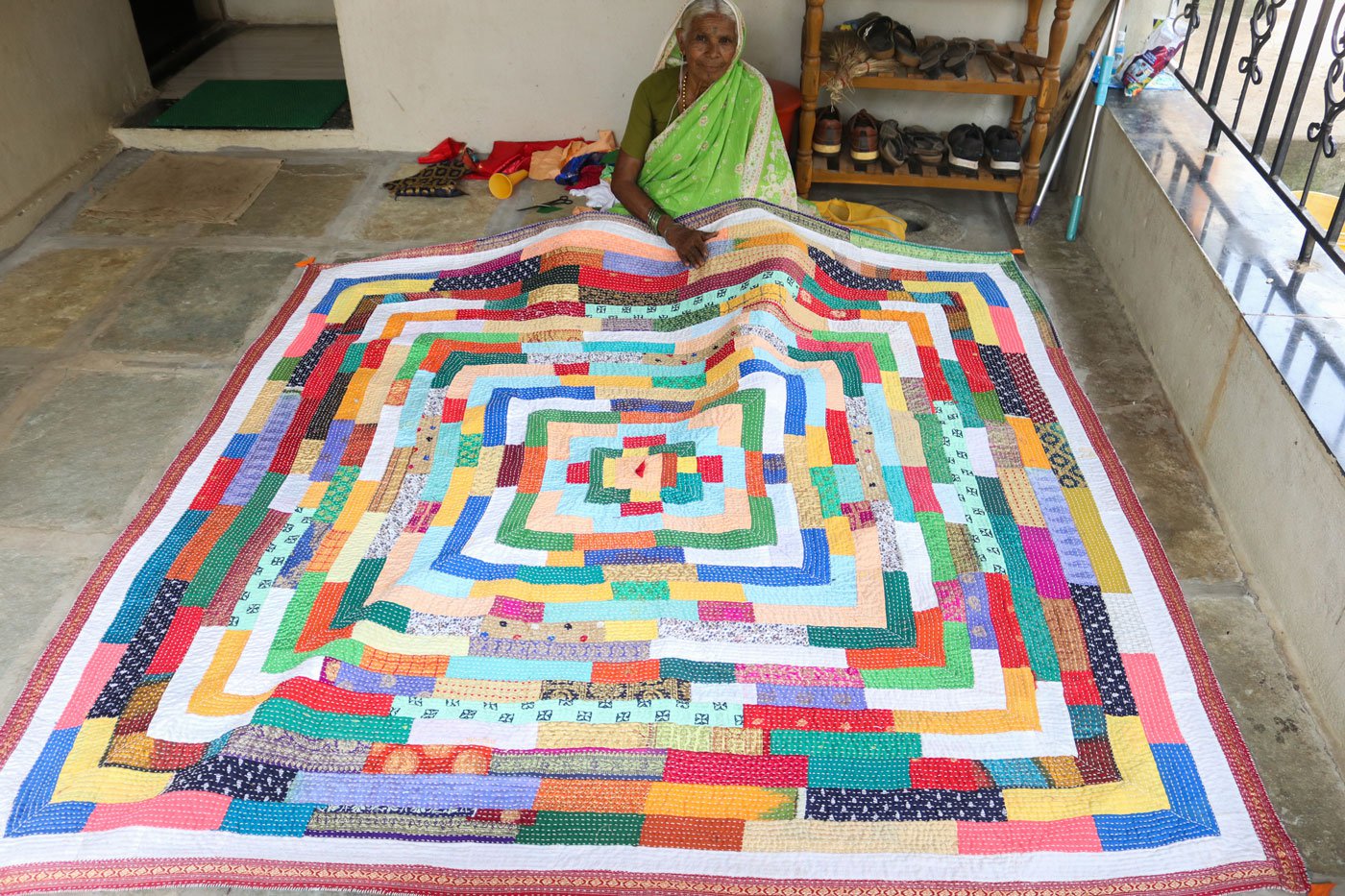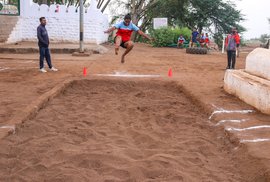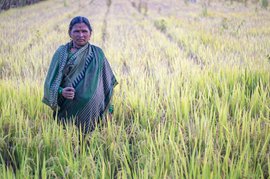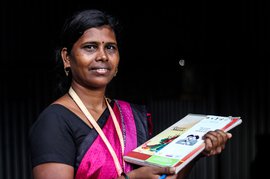Course correction is not an option for Tanubai Govilkar. There is only one way to rectify even a single error in the fine stitches she is painstakingly making by hand – redo the entire process. Which means, undoing about 97,800 stitches and starting over.
“If you make one mistake, then you can’t fix the
vakal
[quilt],” says the frail 74-year-old about the precision her craft demands. Yet, she can’t remember a single woman who has ever had to redo the stitches of a
vakal
. “
Ekda shikla ki chuk hot nahi
[Once you learn this skill, you won’t make a mistake],” she says, smiling.
She herself never intended to learn this meticulous art. Life – and questions of survival – made her pick up the needle. “
Potane shikavla mala
[Poverty taught me this art],” she says, tracing her life back to the early 1960s, when she was a 15-year-old bride.
“During the age of schooling, I had a sickle and needle in my hand instead of a pen and a pencil. Had I gone to school, [do] you think I would have learned this skill?” asks Tanubai, or Aaji (grandmother) as she is affectionately called.
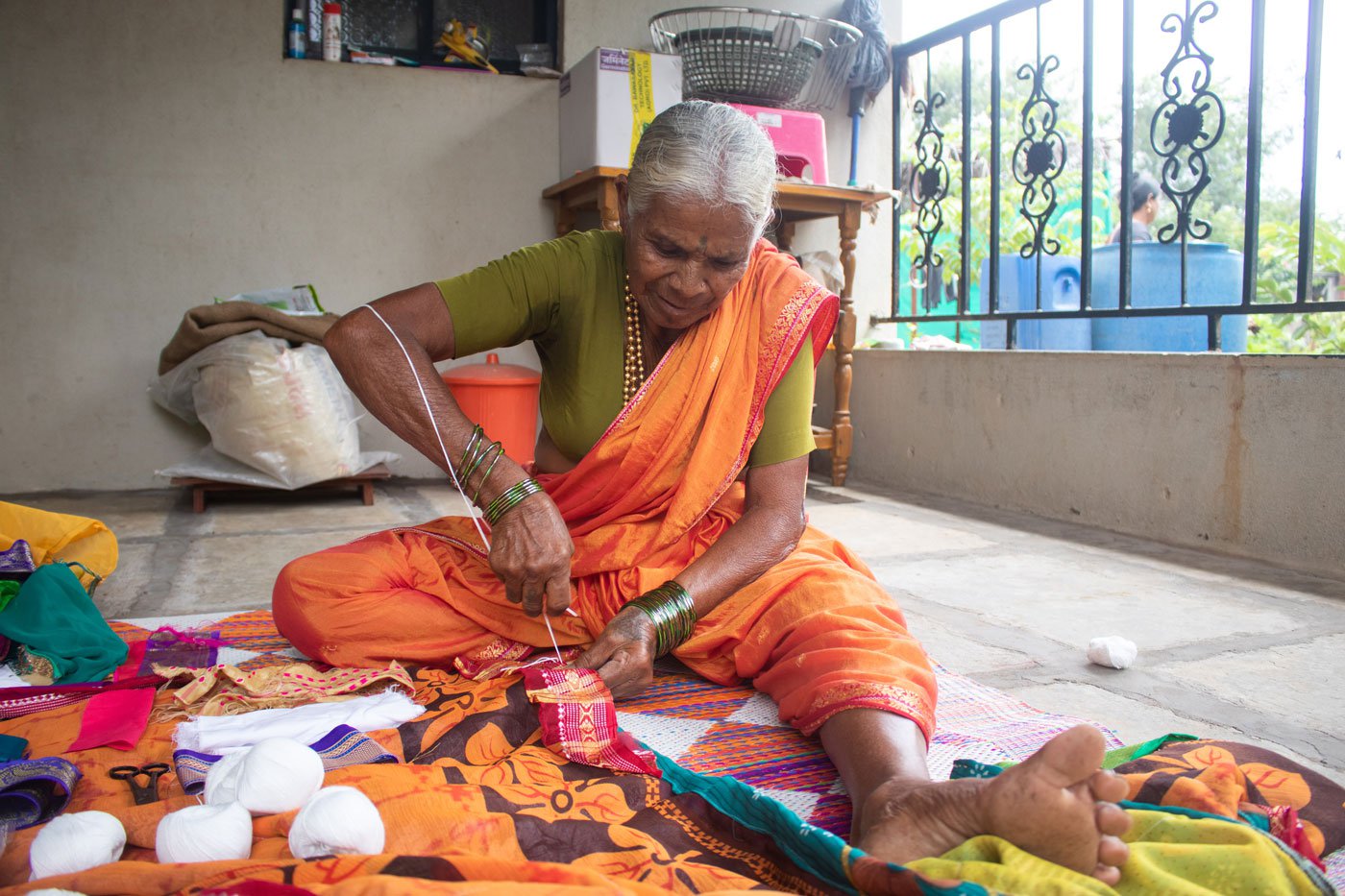
Tanubai Govilkar, affectionately called
Aaji
(grandmother), working on a
vakal
. Every stitch of the
quilt requires an agile movement of the arms
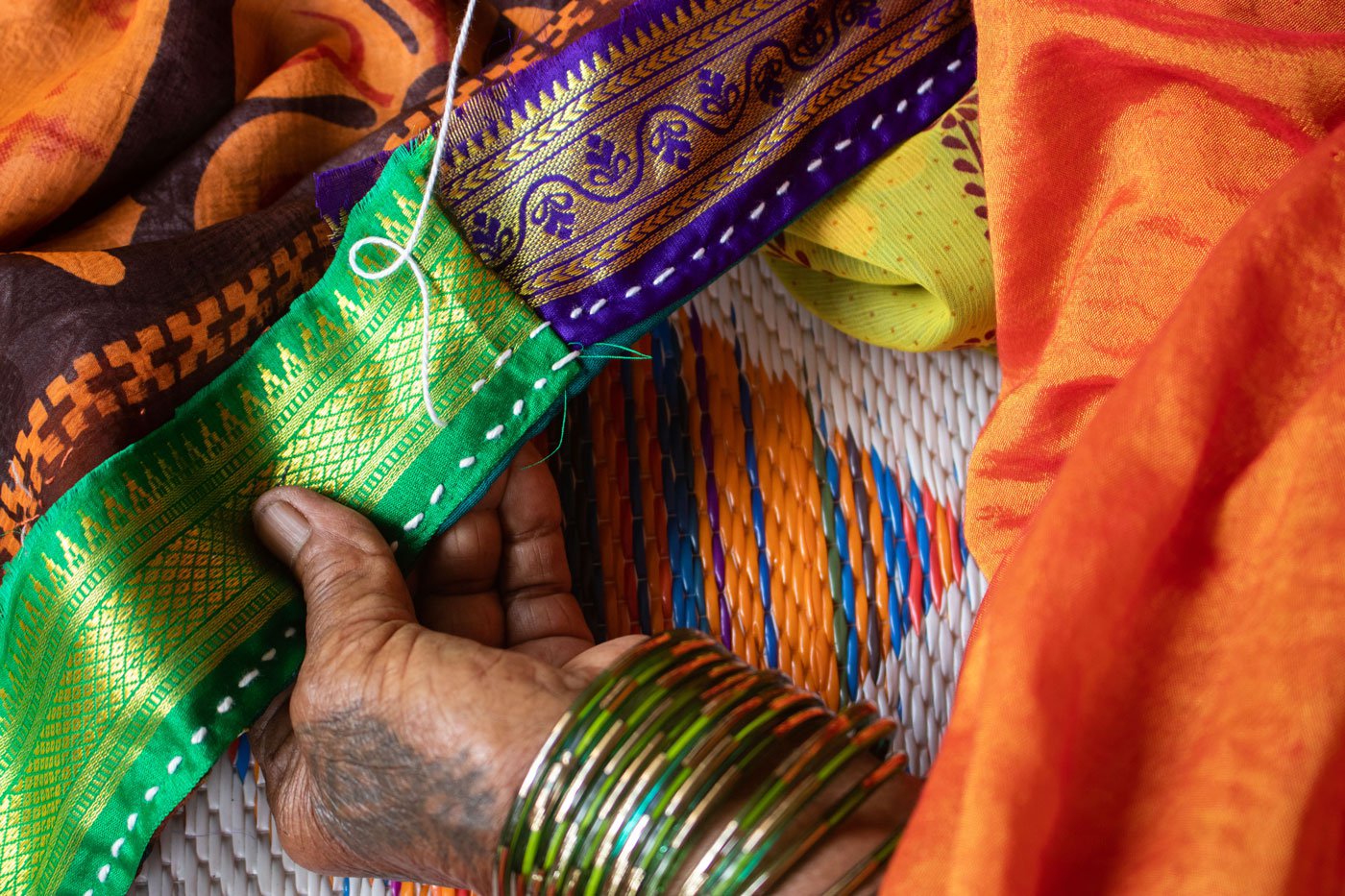
Stitching the
thighal
, a smaller piece cut of a saree, requires precision. Tanubai stitches them
on the topmost layer one by one, eventually creating a colourful, symmetrical pattern.
“
A minute error can affect the lifespan and quality of the
vakal
”
As agricultural labourers, she and her (late) husband, Dhanaji, both belonging to the Maratha community, barely made ends meet; buying quilts to keep themselves warm during winters was a luxury beyond their means. “The quilts back then were unaffordable,” she recalls, “so women would stitch old sarees to make their own quilts.” Thus, after slogging in the fields all day, Tanubai would spend her evenings bent over a vakal - in-progress.
“
Shetat khurpa gheun bhangalela bara, pan ha dhanda nako
[Weeding in a farm with a sickle is way better than this work],” she says. The reason: a single
vakal
involves intricate needlework spread over 120 days and roughly 600 hours. Throw in frequent backaches and strained eyes, and it’s easy to see why Tanubai believes working with the sickle is easier than labouring with the needle.
It also explains why she is the sole practitioner of
vakal
craft
among the 4,963 residents (Census 2011) of the village of Jambhali, in Maharashtra’s Kolhapur district.
*****
The first step in making a vakal is to carefully assemble the sarees, a process known as leva in local Marathi. The number of sarees in a vakal varies by the artisan. Women usually decide the number depending on the time available on hand. Tanubai uses nine suti (cotton) or nauvari (nine yards long) sarees for her latest vakal .
First, she cuts a single saree into two halves and spreads them on the floor. Upon this, she places another layer of two sarees folded in half. In total, she stacks four such layers of eight sarees. Then, with the help of basting stitches, which are loose and temporary, she
joins all nine sarees, ensuring the base remains sturdy. “As you keep stitching the
vakal
, these [temporary] stitches are removed,” she explains.
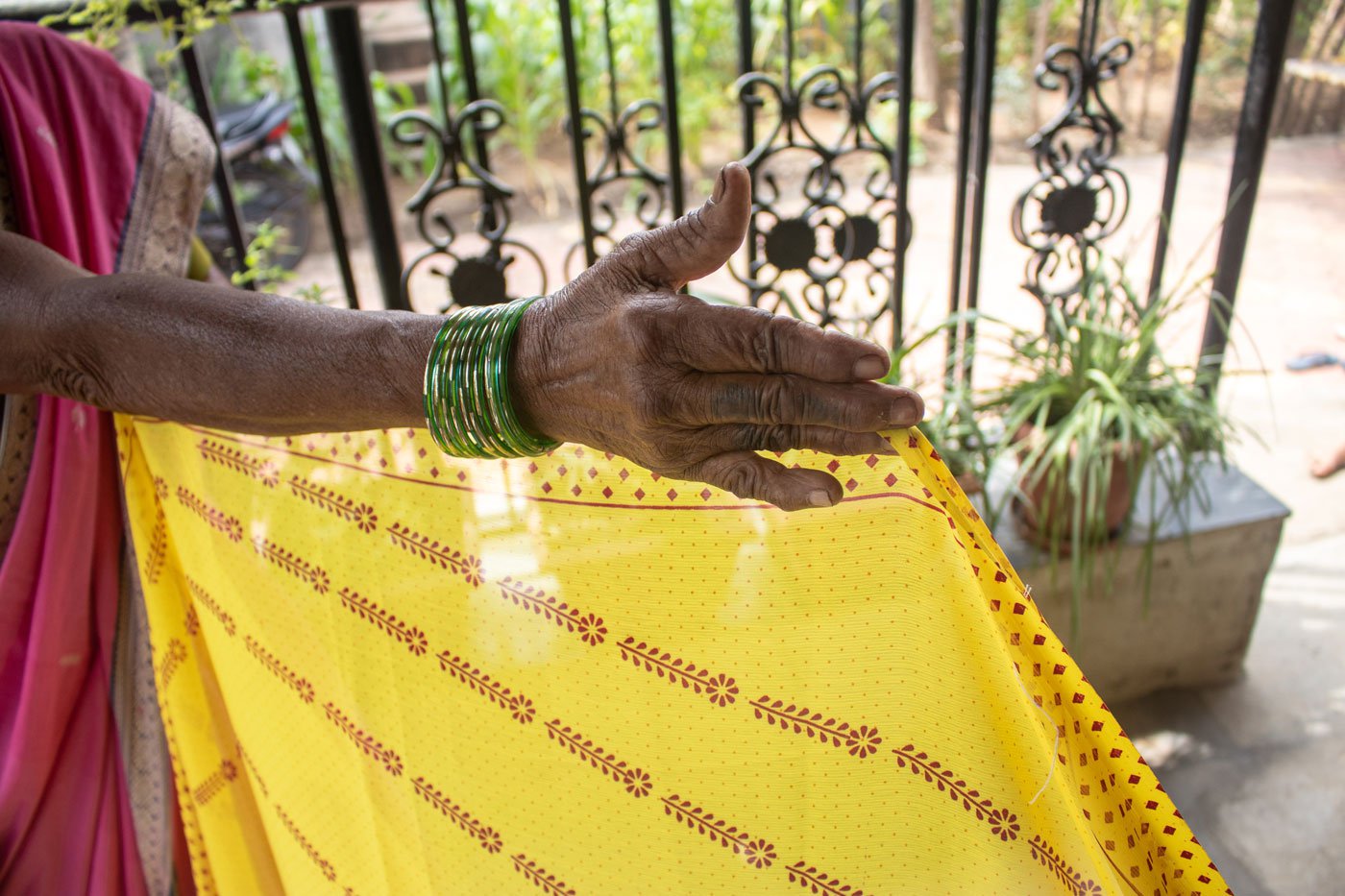
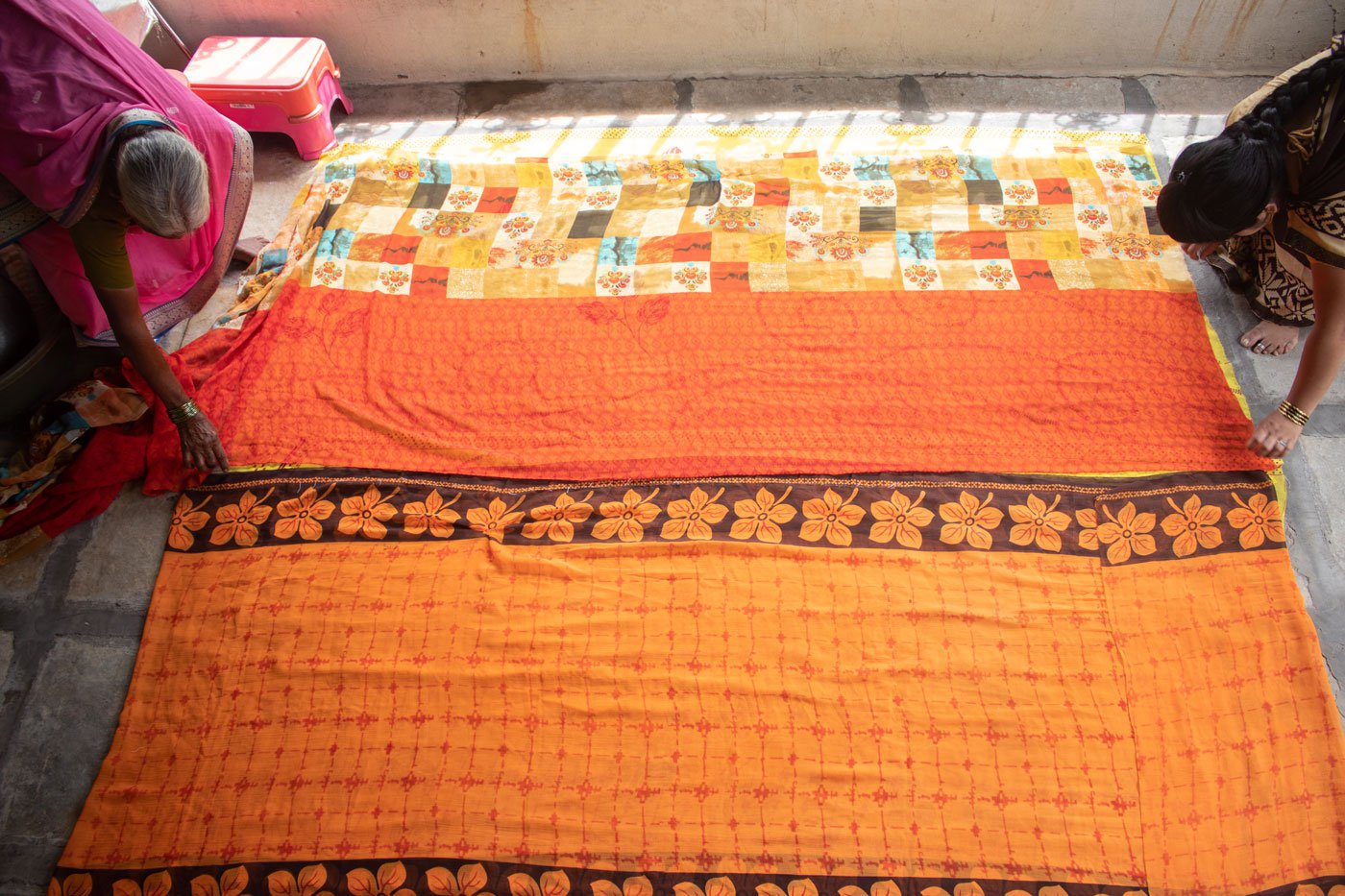
Left: Aaji has never used a measuring tape while cutting the old sarees with which she make a vakal ; she roughly measures the length of the cloth with her hands. Right: A saree is cut in half with scissors, and then Tanubai prepares an assemblage, known as leva , with five layers of cut cloth
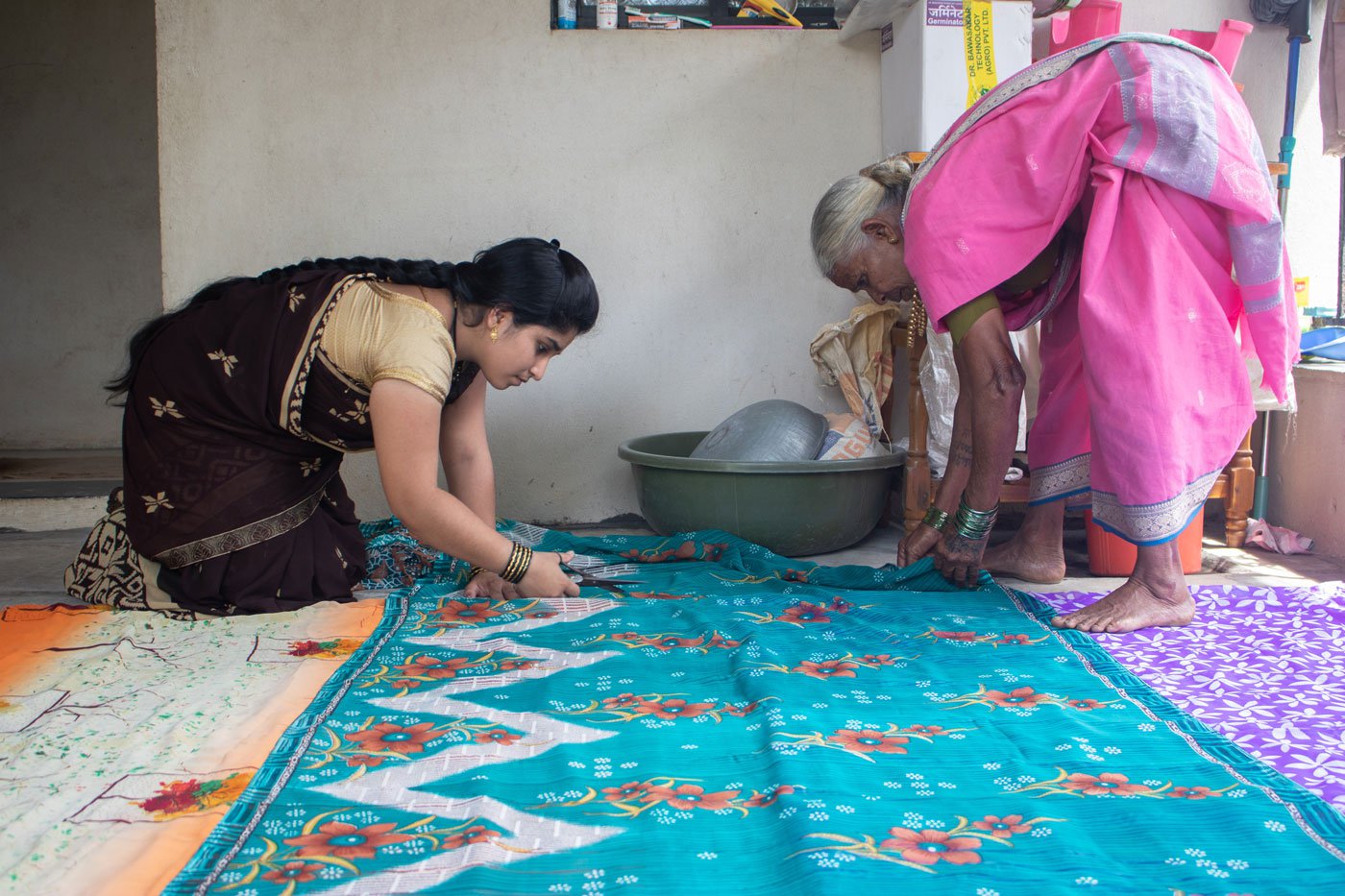
Ashwini
Biranje (left),
Aaji's granddaughter-in-law
, helps her in making the
vakals
Aaji then cuts more sarees into smaller pieces known as thigh al , which she stitches onto the topmost saree, one by one, eventually creating a colourful, symmetrical pattern. “There’s no planning or drawing required for this,” she says. “You just pick up the thighal and keep stitching.”
Her
fine stitches measure 5 mm each and begin from the outer-most border; with every stitch, the
vakal
gets heavier, straining the hands that give it shape. She uses 30 spools, or 150 metres (about 492 feet), of white cotton thread and several needles to stitch the
vakal
. She buys the thread, at Rs. 10 a spool, from the nearby Ichalkaranji town, 12 kilometres from Jambhali. “Earlier, only thread worth Rs. 10 would be required for stitching a
vakal
; today the cost has gone up to Rs. 300,” she
complains mildly.
Just before making the final set of stitches, Aaji lovingly puts a piece of
bhakri
inside the
vakal
’s
centre or its
pot
(stomach) – an offering of deep gratitude for the warmth the quilt will provide. “
Tyala pan pot aahe ki re bala
[Even the
vakal
has a stomach, child],” she says.
The
vakal
is ready once four triangular shaped cutouts are attached to its corners, a design that is not only characteristic of these quilts but also has an important role to play – the four corners provide an easier grip to lift the heavy
vakal
. The 9 sarees, 216
thighals
and 97,800 stitches add up to a
vakal
that weighs over 7 kilos.
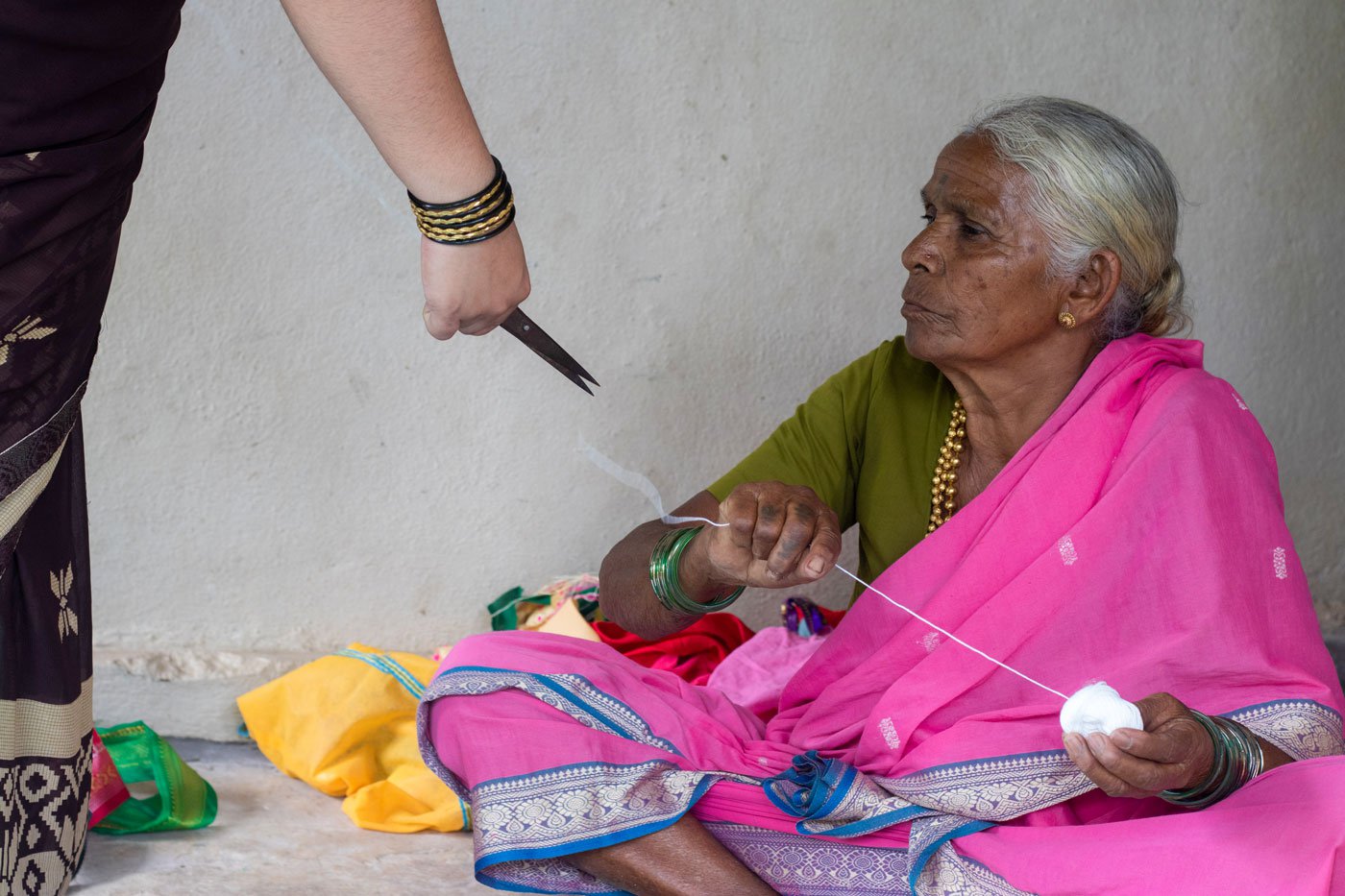
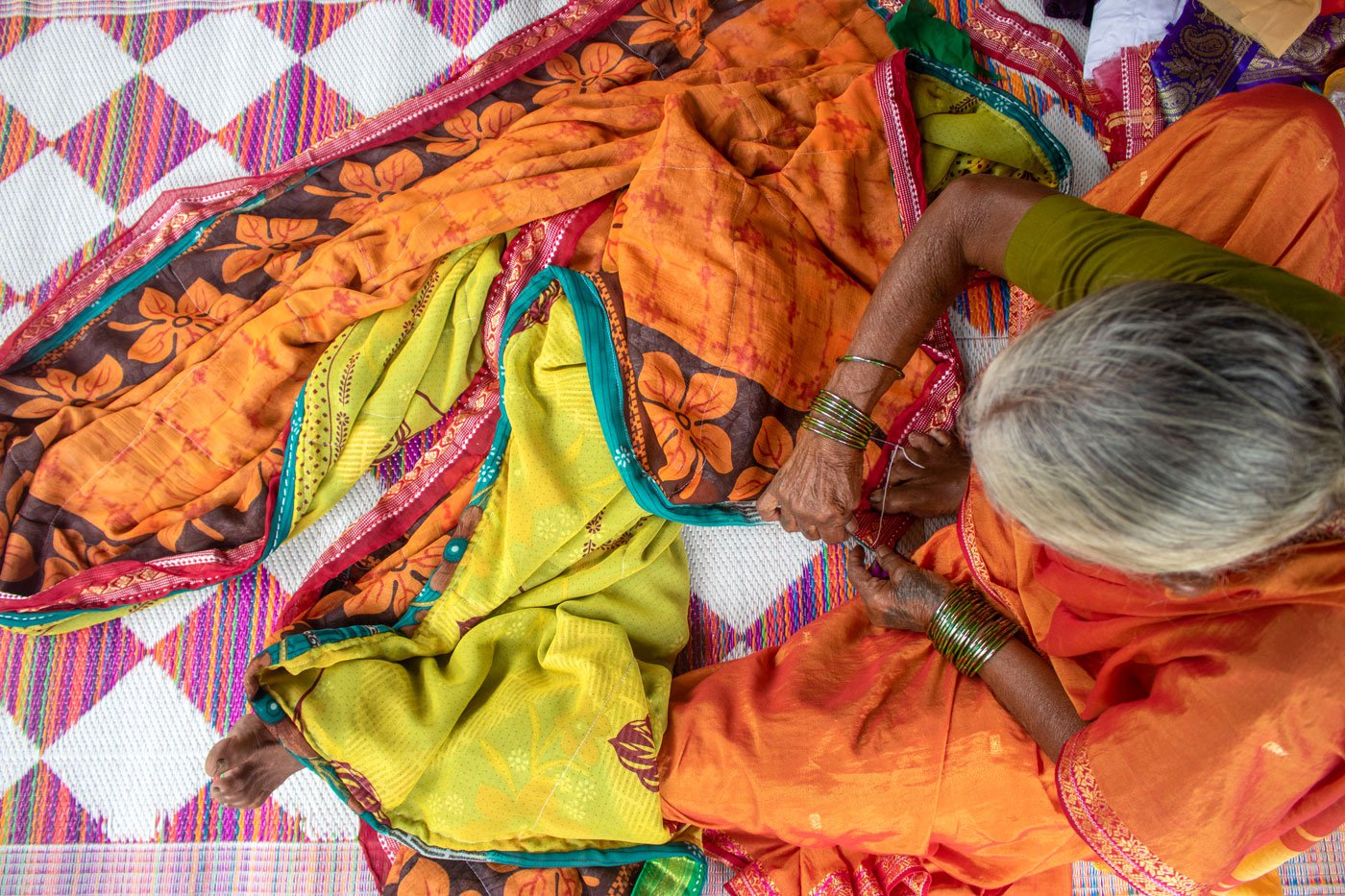
About 30 spools (150 metres) of white cotton thread and several needles are used by Tanubai to make a quilt
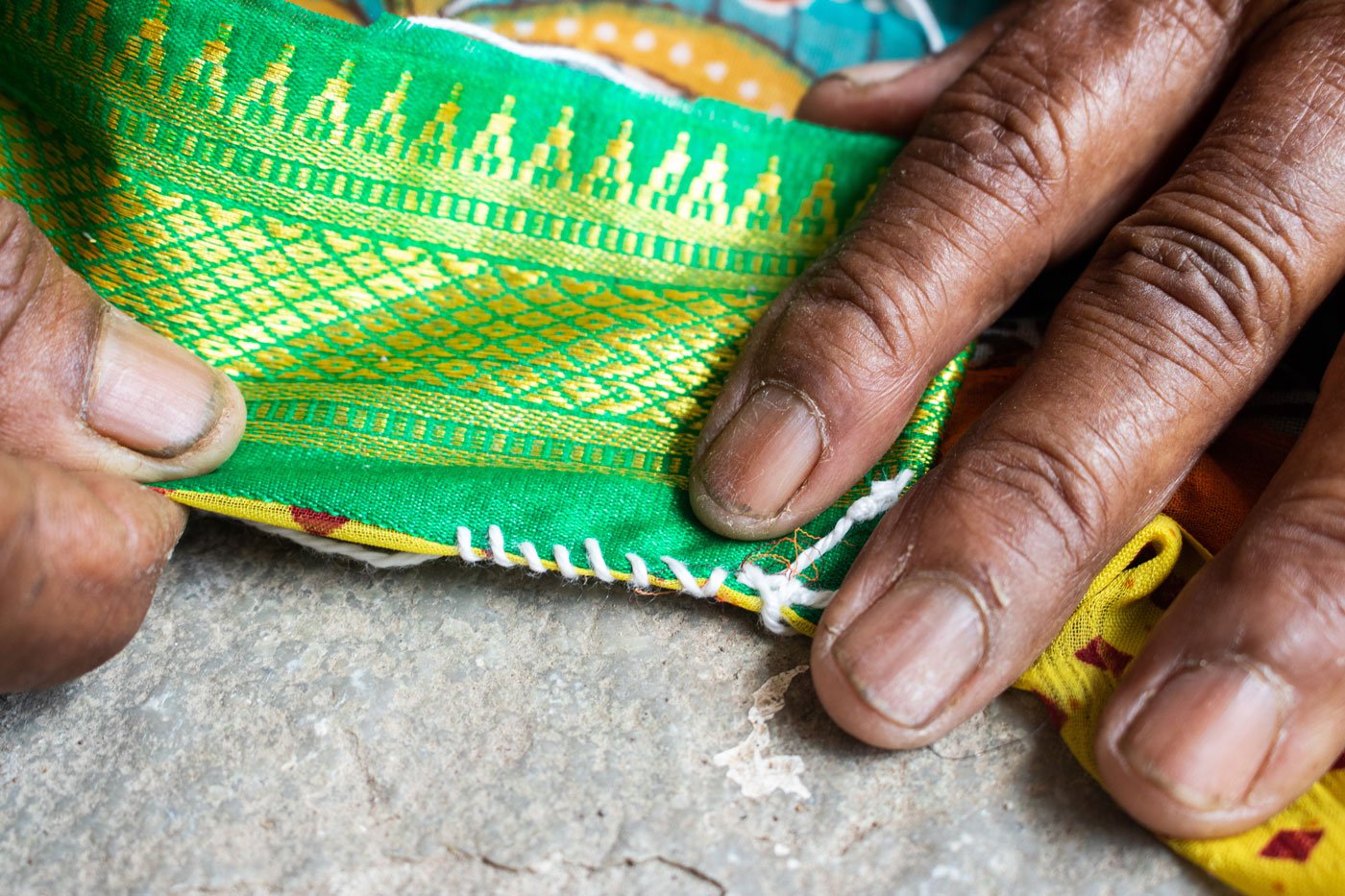
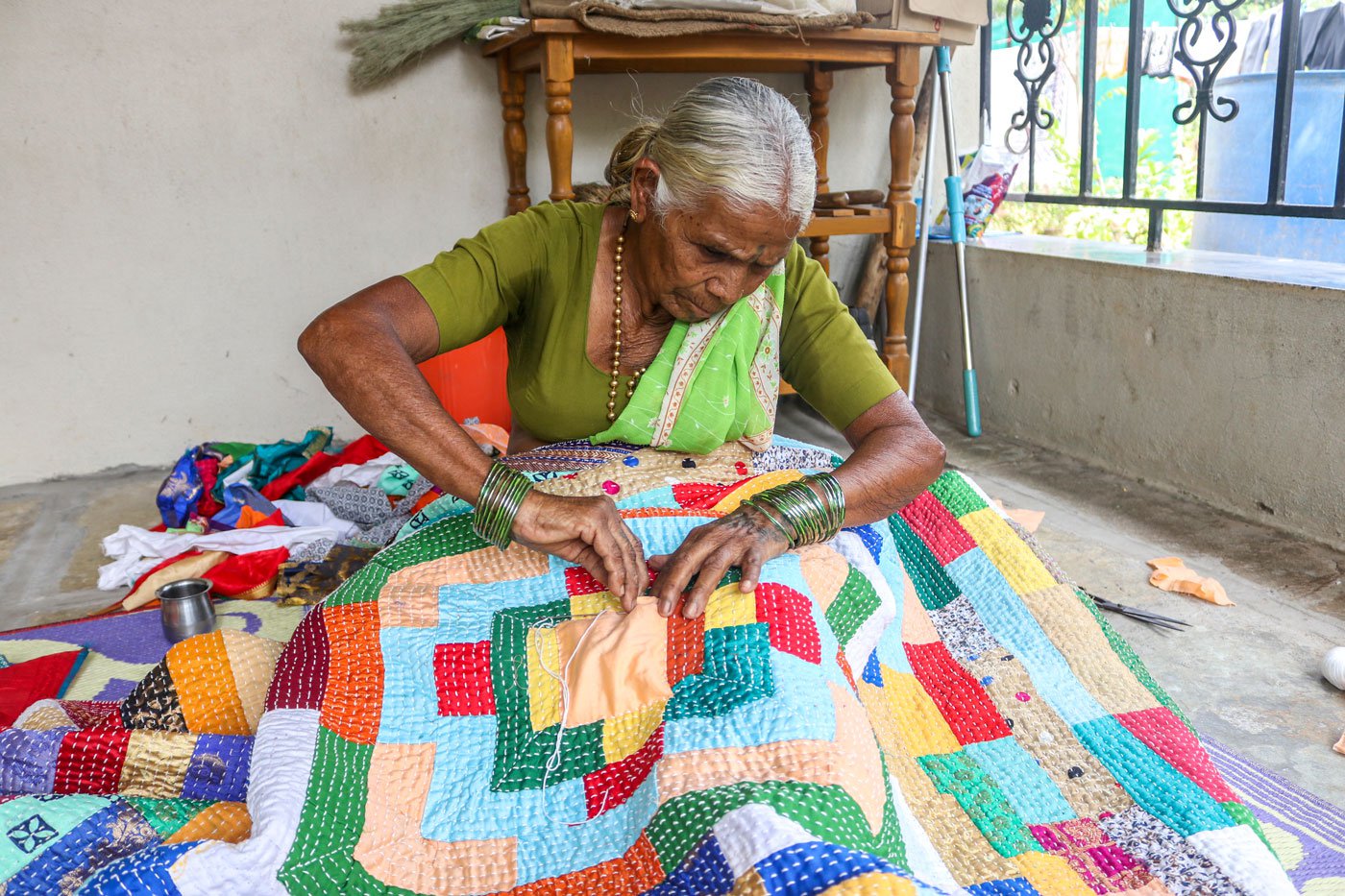
Left : She begins by putting fine stitches on the outer-most border, which secures the strength of the vakal . Right: Before finishing up, Aaji puts a piece of bhakri at the centre of the quilt as an offering of gratitude for the warmth it will provide
“This is four months of work finished in two,” Aaji says, proudly showing off her latest vakal , a beautiful 6.8 x 6.5 feet creation. She is sitting in her usual workspace, the cemented porch outside her elder son Prabhakar's pucca house. She has adorned it with plants such as tuberose and coleus, carefully collected over the years. The floor, which Aaji used to once pave with cow dung, has been a witness to her spending thousands of hours putting together magnificent creations from countless shreds of cloth.
“At least four people are required to wash a
vakal
. It’s that heavy,” she says, adding
v
akals
are washed thrice a year – on Dussehra, Navyachi Poonam (first full moon after the festival of Sankrant) and the annual village fair. “I don’t know why these three days are selected, but that is the tradition.”
Tanubai
has made over 30
vakals
in her lifetime, devoting over 18,000 hours to this intricate, intense art. And that was just her part-time work. For over six decades of her life, she was also a fulltime agricultural labourer, putting in 10 hours of back-breaking work in the fields, every day.
“Despite working so much, she’s not tired. Whenever she finds free time, she starts making another
vakal
,” says her daughter, Sindhu Biranje, who never learned this art. “None of us will be able to match her level even in an entire lifetime. We are fortunate to see her work even today,” adds Lata, Tanubai’s elder daughter-in-law.
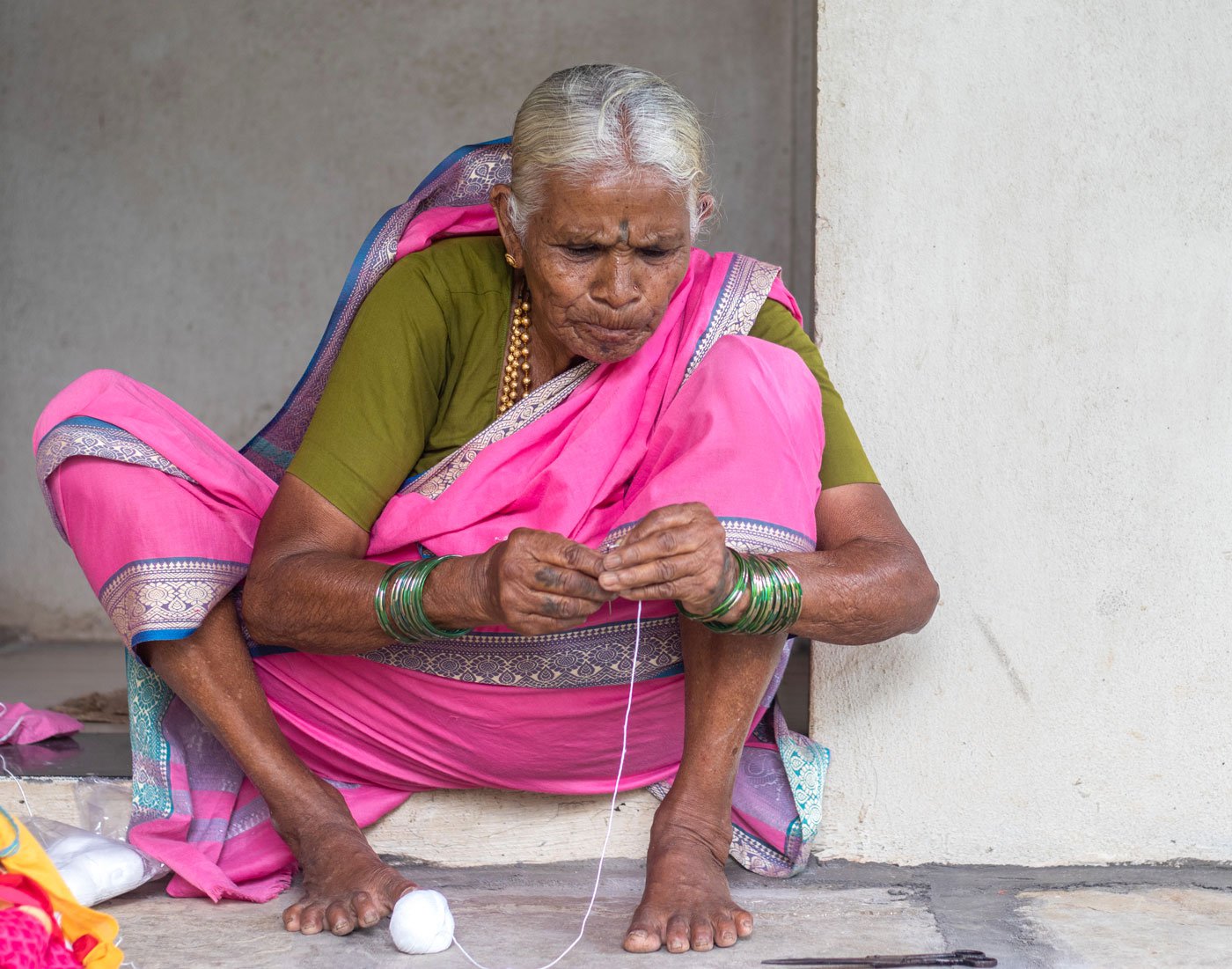
Tanubai says she can thread a needle even in her sleep
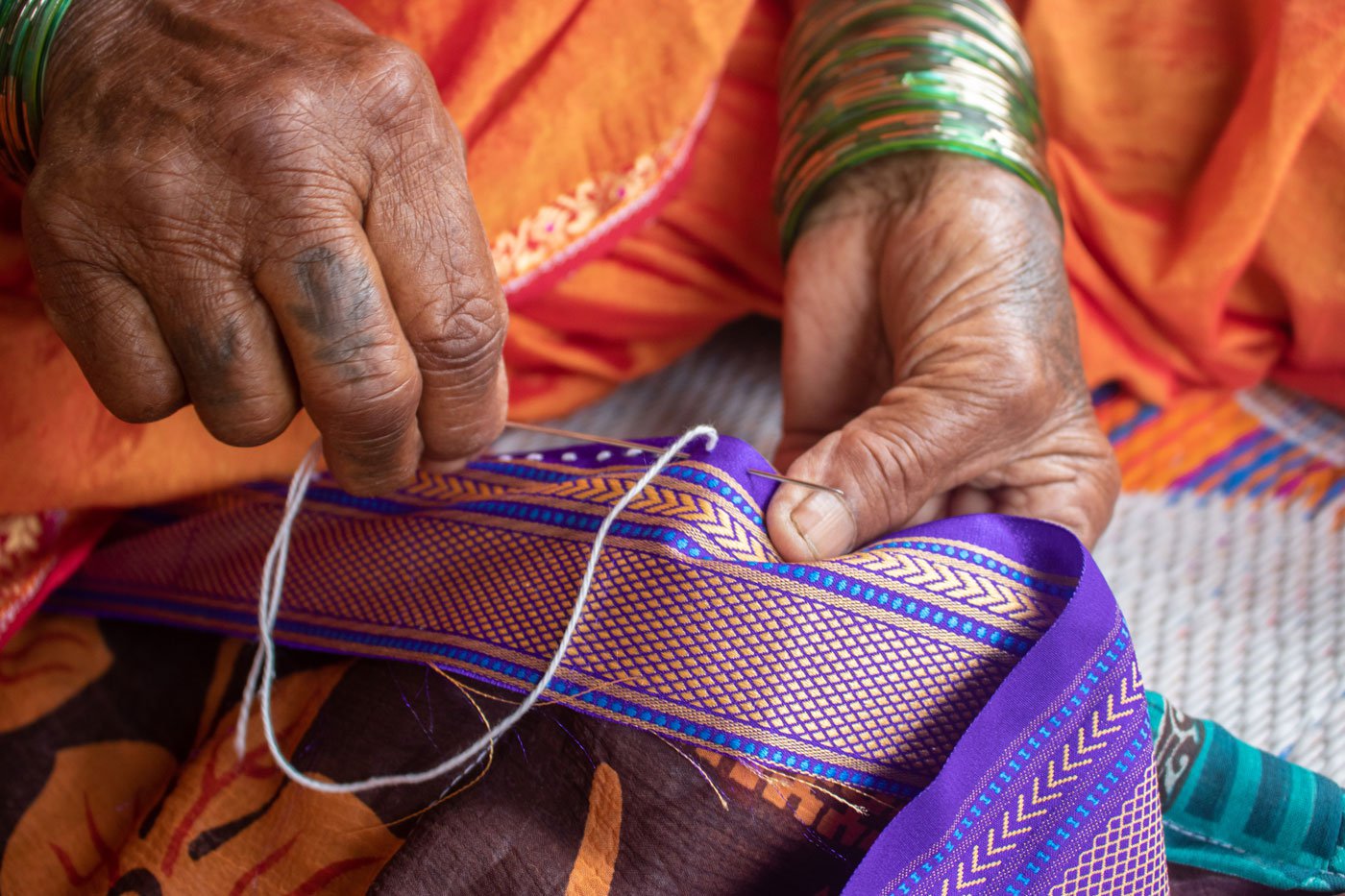
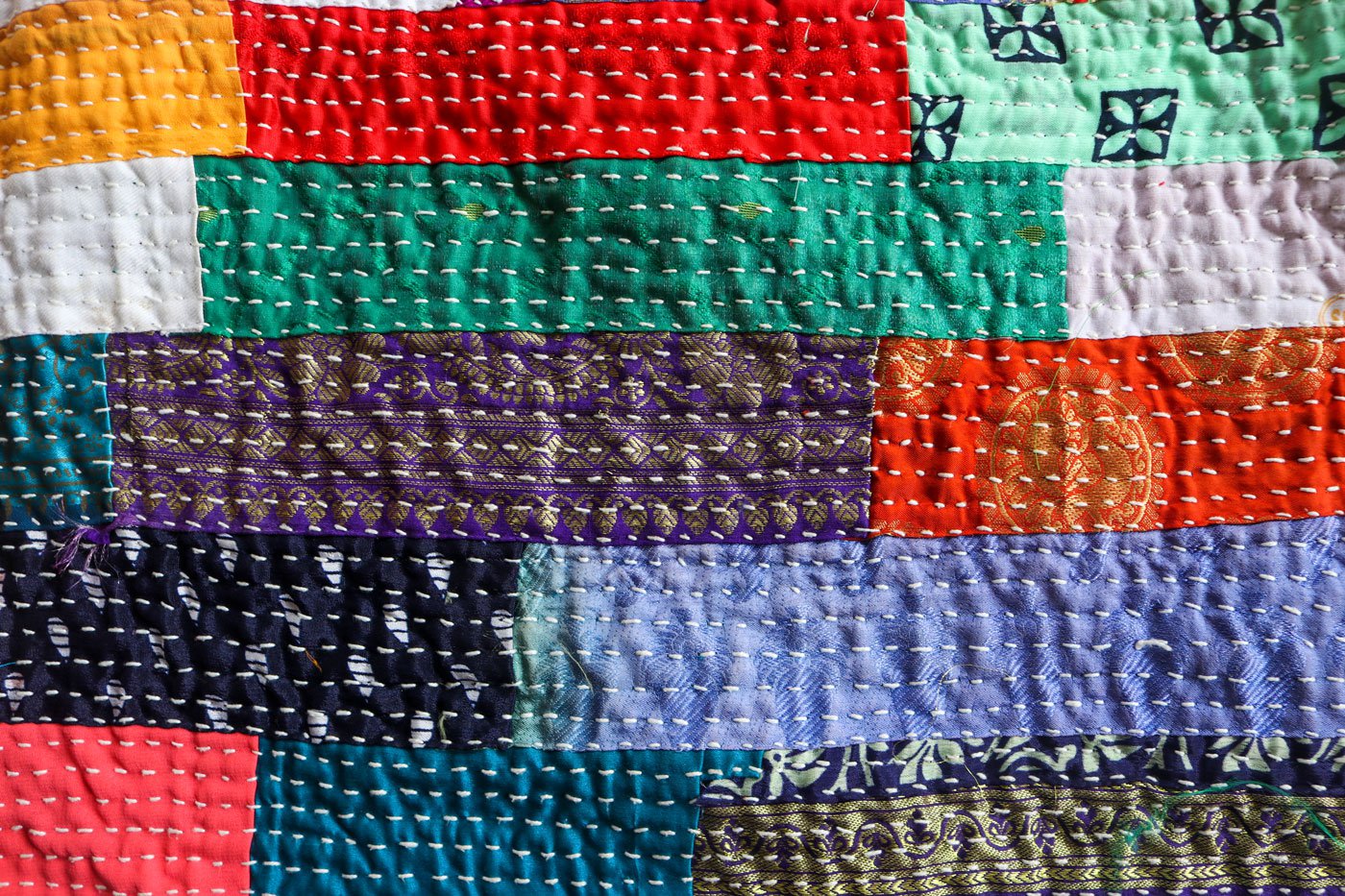
Left: The intricate needlework strains her arms and shoulders. “ These hands have become like steel, so the needles don’t bother me now. ” Right: Her evenly spaced running stitches measure 5 mm in length. They hold the layers together, and the vakal gets heavier with every stitch
Sindhu’s daughter-in-law, Ashwini Biranje, 23, has completed a tailoring course and knows how to make vakals . “But I make vakal using a machine. This traditional art requires a lot of patience and time,” she says. What she doesn’t say is that it’s also physically strenuous work that hurts the back and eyes, and leaves the fingers bruised and sore.
But Tanubai doesn’t make much of it. “My hands are now used to it. These hands have become like steel, so needles don’t bother me,” she laughs, gently tucking her needle in her braid every time someone interrupts her work. “This is the safest place to keep a needle,” she says, grinning.
Ask her why the younger generation is not keen to learn this art and she retorts, “
Chindya fadayla kon yenar? Kiti pagar denar
?
[Who will come to tear the sarees? How much will you pay them anyway?]”
Young people prefer buying cheaper, machine-made quilts from the market, she explains. “Unfortunately, only a few women know how to make
vakal
by hand. The ones who are still in awe of the art get it stitched on a machine,” says Tanubai. “This has completely changed the reason why
vakals
were made, but then things change with time,” she adds. Women also prefer using new sarees to make
vakals
instead of old ones, she points out.
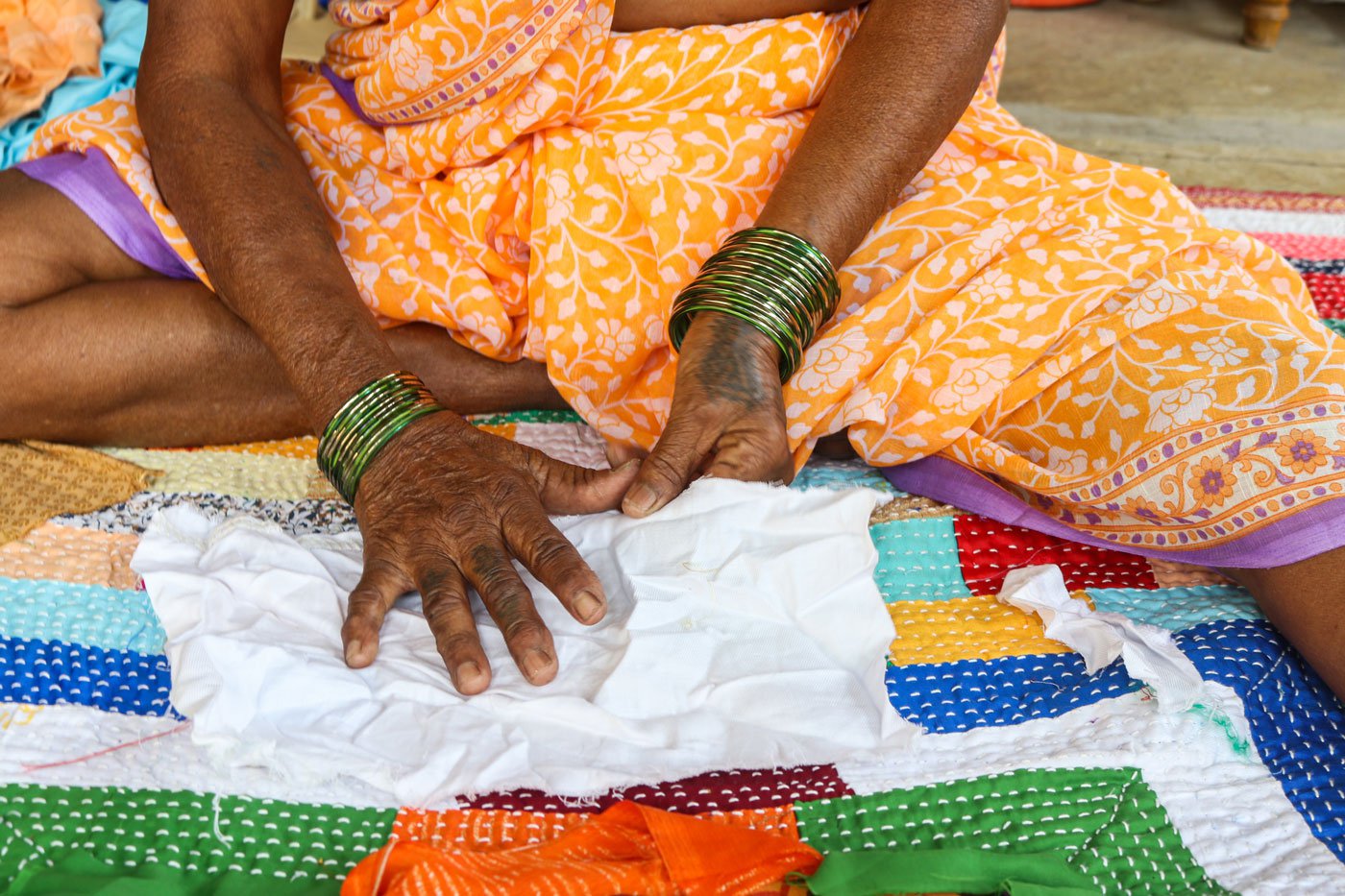
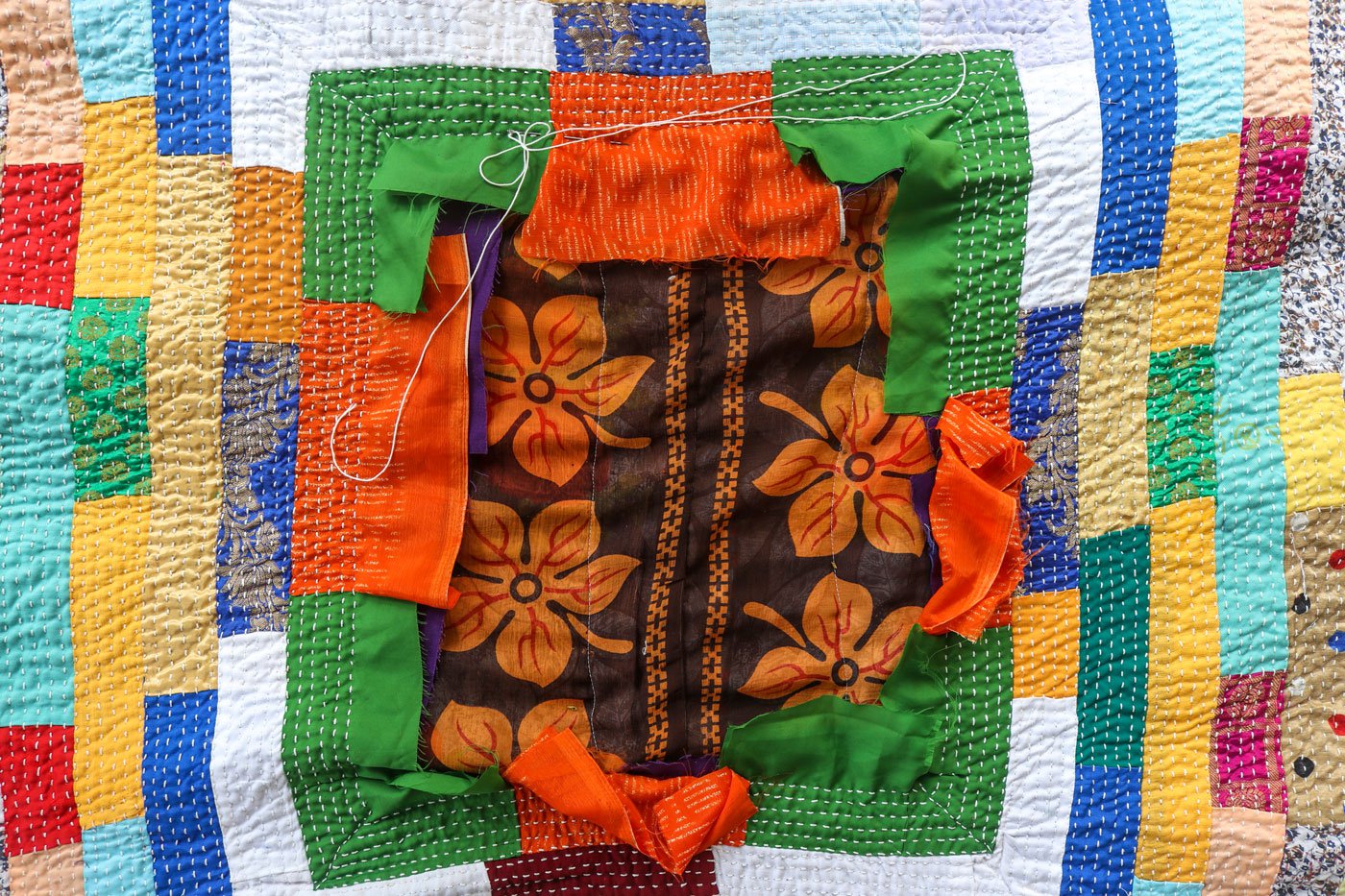
Left: Tanubai measures the
thighals
with her hand before arranging them for stitching. Right: She has made 30
vakals
in her lifetime, devoting over 18,000 hours to the art
After having spent a lifetime making millions of exceptional stitches by hand, she still regrets not following the advice of the friendly neighbourhood tailor, Naik (Aaji doesn’t remember his first name). “He would keep asking me to learn tailoring,” she reminisces. “Had I learned it, my life would have been completely different today.” Not that she loves the craft any less because of the labour it demands.
Interestingly, Tanubai has never sold a vakal in her lifetime. “ Kashala re mi viku vakal, bala [Why should I sell this, son]? How much will one pay for it?”*****
Although there was no fixed time of the year to make vakals , it somehow followed the rhythm of the farming cycle; women preferred stitching when there was less work in the fields, usually from early February to June. “ Manala yeil tevha karaycha [We made it whenever we felt like],” says Tanubai.
She remembers that in Naukud, her old village in Kolhapur’s Gadhinglaj
taluka
, almost every household made a
vakal –
also known as
godhadi
in other parts of Maharashtra
–
till the late 1960s. “Earlier, women invited neighbours to help stitch a
vakal,
paying three anna [a pre-metric currency unit] for a day’s work.” If four women worked continuously, she says, it would take two months to finish one quilt.
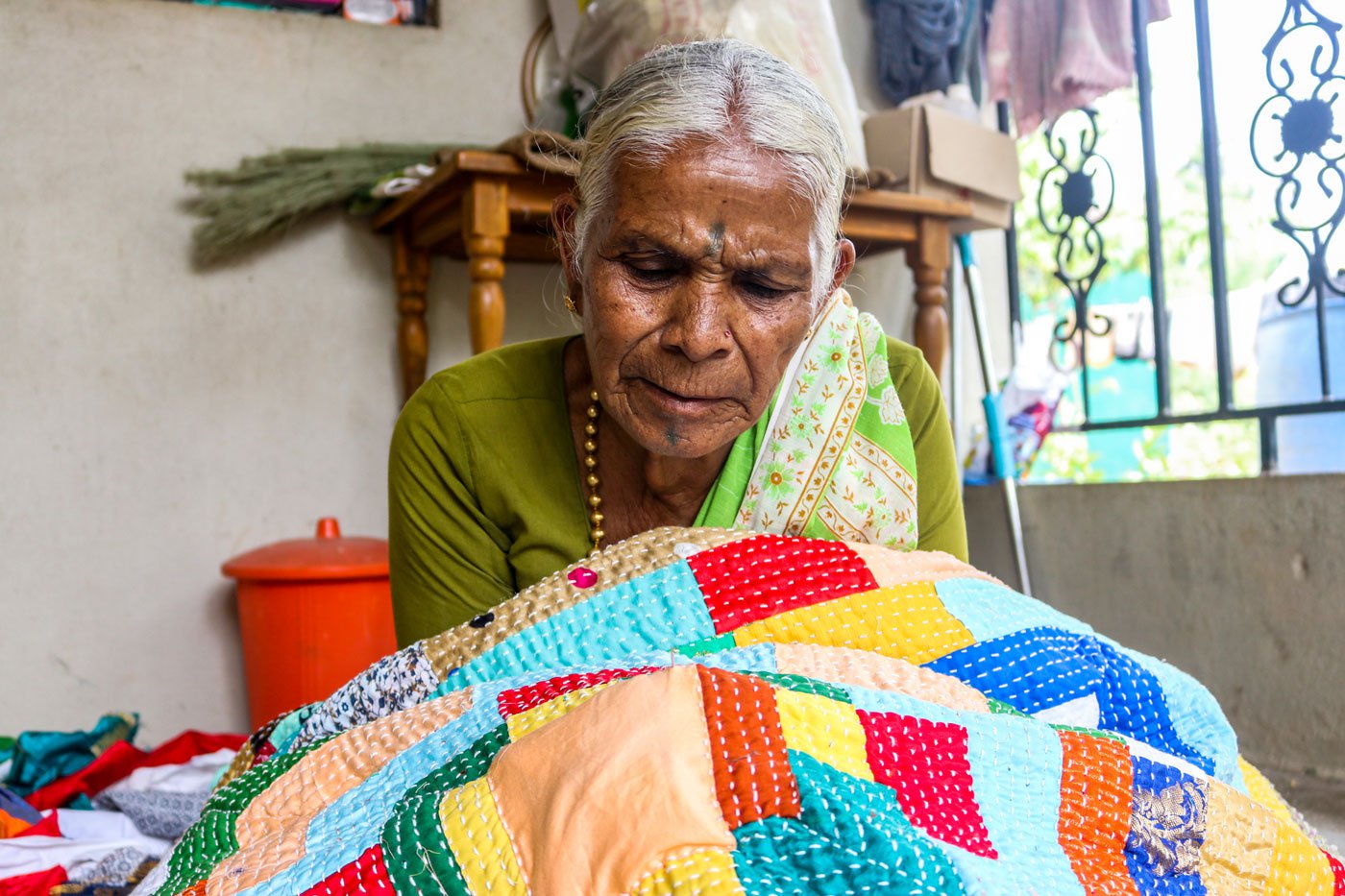
The last set of stitches is the most difficult as the quilt
is quite heavy by then
Sarees were costly back then, she recalls. A cotton saree would cost Rs. 8 and the good ones Rs. 16. Princely sums, considering a kilo of masuri dal (red lentil) cost 12 anna and she herself earned 6 anna a day toiling in the fields . Sixteen anna made a rupee.
“We used to buy only two sarees and four
jhampar
[blouses] in a year.” Given how scarce sarees were, the
vakal
had to have a longer lifespan. Tanubai proudly says that her
vakals
last at least 30 years
–
a sublimity achieved through intense practice at mastering the finer details of the art.
It was the 1972-73 drought, which severely
affected 200 lakh people
(57 per cent of Maharashtra's rural population), that forced the Govilkars to migrate from Naukud to Jambhali village in Kolhapur’s Shirol
taluka
, about 90 kilometres away. “One shouldn’t even remember the drought. It was that terrifying. We slept on empty stomach for several days,” she says, her eyes misting over.
“A resident of Naukud found some work opportunities in Jambhali. Without thinking much, almost the entire village migrated,” she remembers. Before migrating, her husband, the late Dhanaji, worked as a labourer building roads and breaking boulders, even travelling as far as Goa, about 160 kilometres from Naukud.
In Jambhali, Aaji was one of over 40 workers constructing a road as part of the government’s drought relief work. “We were paid only Rs. 1.5 per day for 12 hours of work,” she remembers. During this time, a village strongman asked them to work in his 16-acre farm for Rs. 3 per day. Tanubai began working as an agricultural labourer, cultivating groundnut,
jowar
, wheat, rice, and fruits like
chikoo
(sapodilla), mango, grapes, pomegranate and custard apple.
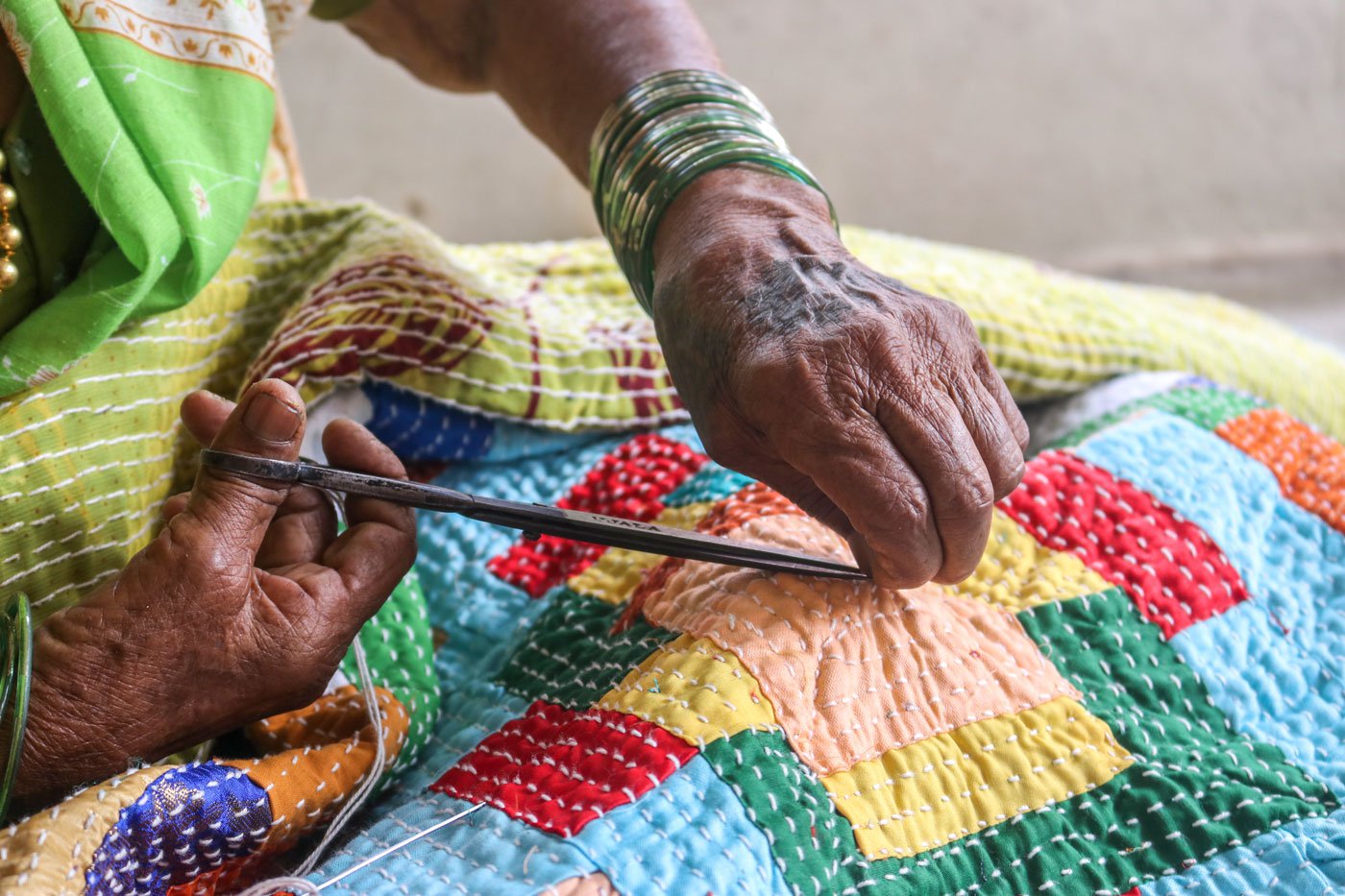
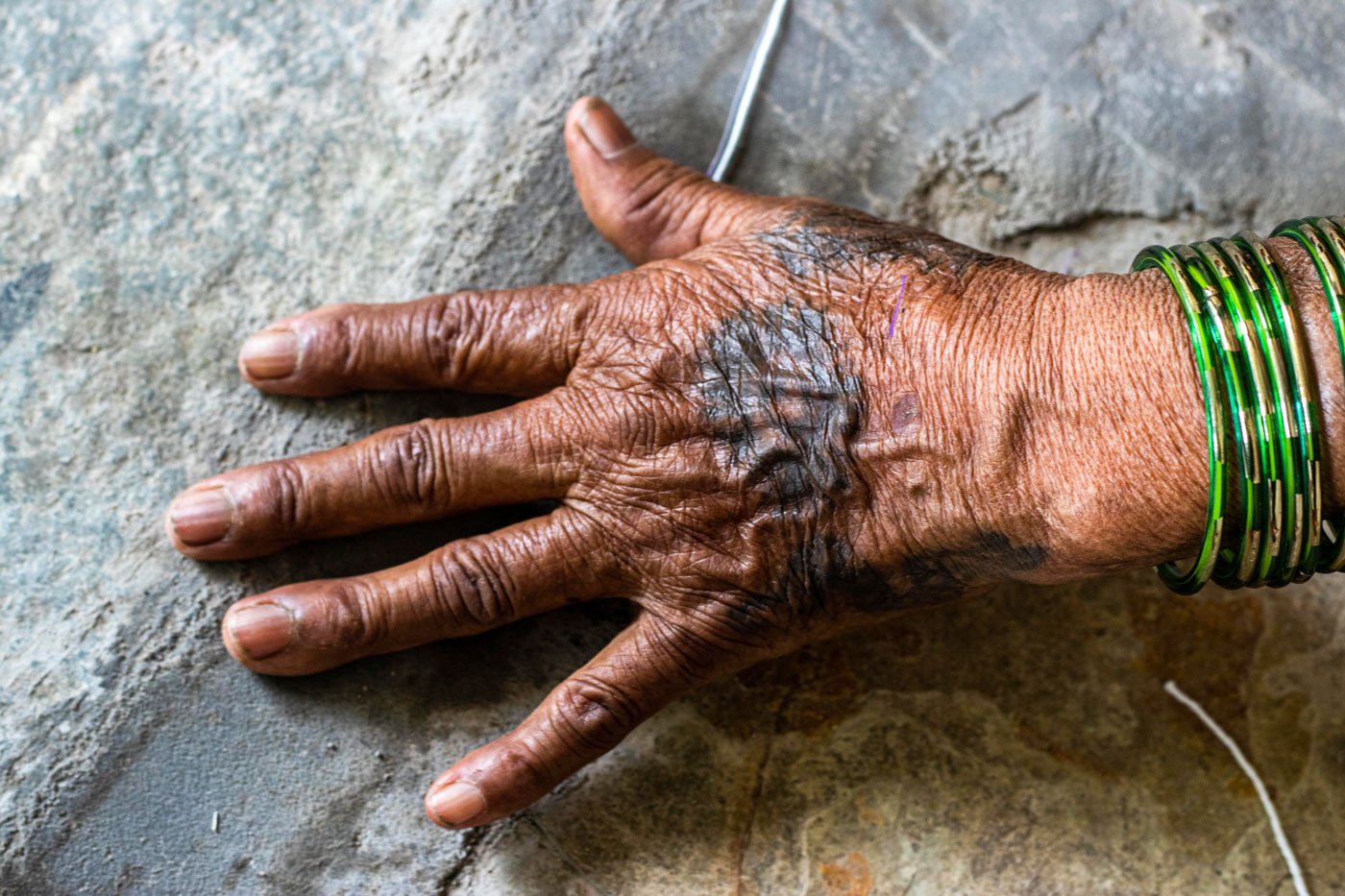
Left:
With this cut,
Aaji’s vakal
is ready. Right: Even after two surgeries on her right shoulder and persistent pain, she hasn
’t stopped making quilts
When she quit the farm in the early 2000s, after more than three decades of hard labour, her monthly salary had increased at the rate of a meagre Rs. 160 per day for a 10-hour workday. “ Kondacha dhonda khalla pan mulana kadhi maga thevlo nahi [We ate husk for our meal, but didn't let our children suffer],” she says, summing up her years of toil and poverty. Her struggle and sacrifice paid off eventually. Today, her elder son, Prabhakar, runs a fertiliser shop in the nearby Jaysingpur town and the younger son, Bapuso, works at a bank in Jambhali.
After she stopped working at the farm, she found herself getting bored and soon started working as an agricultural labourer again. Three years ago, injuries sustained after a fall at home forced her to retire from farm work. “Despite two surgeries on my right shoulder and six months of hospitalisation, the pain persists,” she explains. However, that didn’t stop her from making another
vakal
for her grandson, Sampat Biranje.
Notwithstanding the nagging pain in her shoulder, Tanubai begins stitching at 8 every morning and continues till 6 in the evening, stopping occasionally to drive away the monkeys eating the corn kept outside for drying. “I don’t mind sharing it with the monkeys, but my grandson, Rudr, loves corn,” she says. She owes a lot to her two daughters-in-law, she adds, for supporting her passion. “I am relieved of household responsibilities because of them.”
At 74, Tanubai continues to wield magic with her needle, never missing a stitch; her skill is sharp as ever. “
Tyaat kai visarnar, bala? Tyaat kai vidya aahe?
[What’s there to forget in this? What skills does it require anyway?]” she asks modestly.
Tanubai has one piece of advice for everyone: “No matter what the circumstances,
nehmi
pramanik rahava
[live life truthfully].” Like the fine stitches that hold the many pieces of a
vakal
together
,
she
has
spent a lifetime
keeping her family together. “
Purn aayush mi shivat gele
[I’ve spent an entire life stitching].”
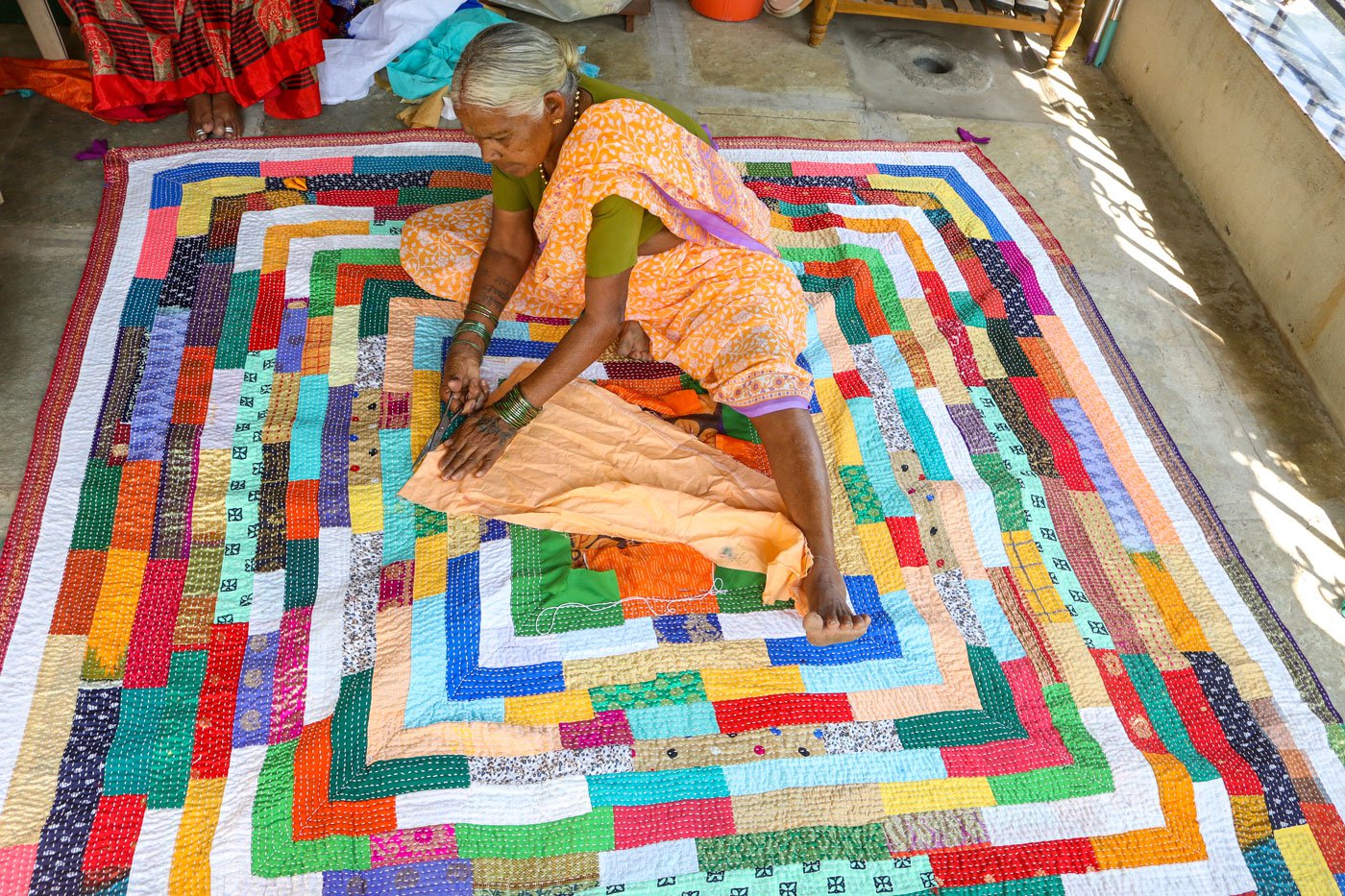
Tanubai stitched this quilt in two months , working almost 12 hours a day
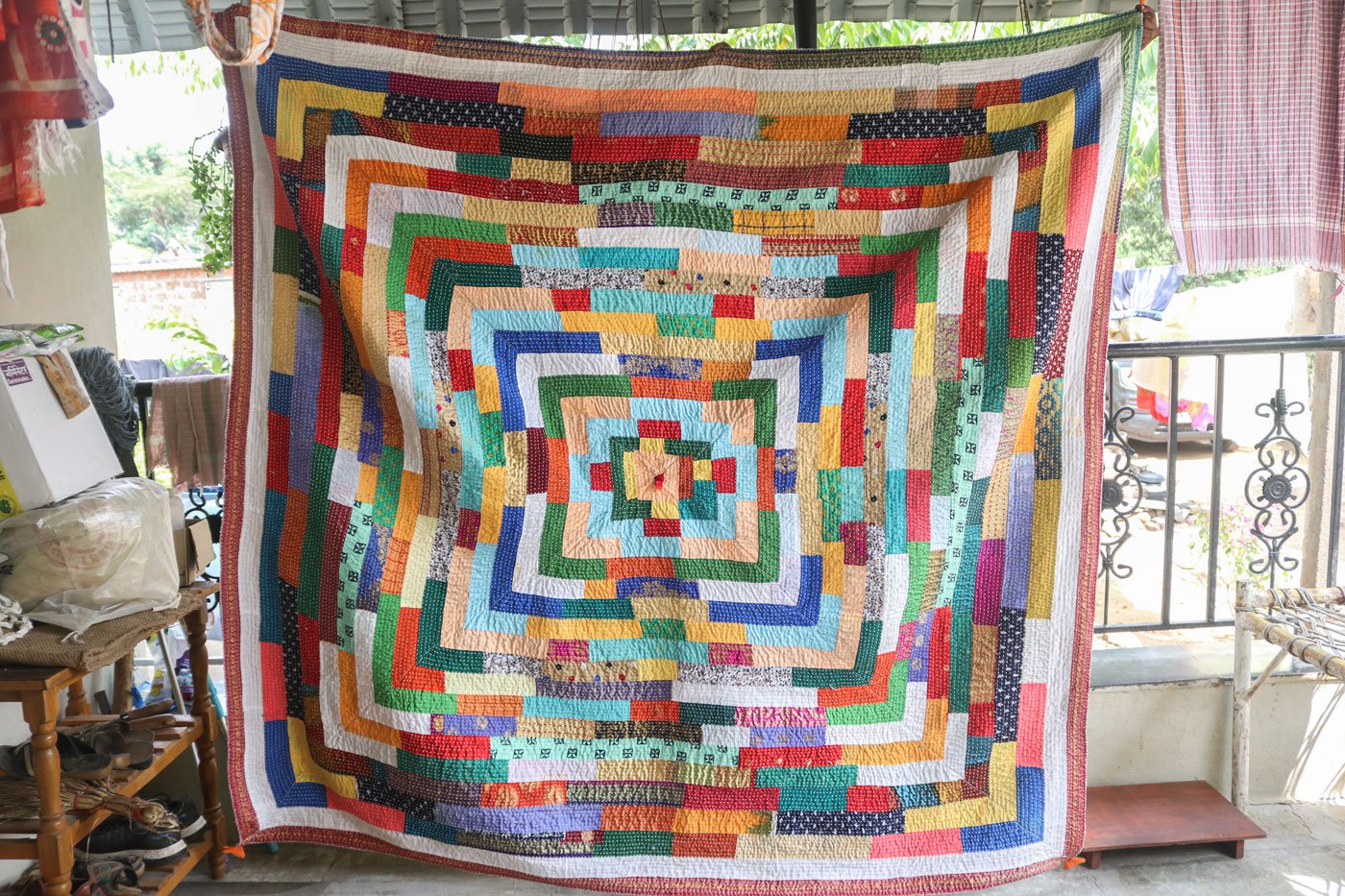
Made
with 9 sarees, 216
thighals
and 97,800 stitches,
the beautiful 6.8 x 6.5 feet
vakal
weighs over 7 kilos
This story is part of a series on rural artisans by Sanket Jain, and is supported by the Mrinalini Mukherjee
Foundation.
